About this Blog: Zangla, located about 30-odd kilometers from Padum is a typical Zanskari village. It is said that Zangla used to be one of the ancient capitals of Zanskar Valley. In your Zanskar trip, Zangla Palace and Nunnery are must-visit places. Read this blog to know about this place and other relevant information that will help you plan your trip to Zanskar Valley.
The first glimpse of proper tarmac roads was like a balm to our eyes. Our backs and midsection seemed to relax a bit, as well. We were approaching Zangla, a place that used to be one of the ancient capitals of Zanskar Valley. Padum, the main town of Zanskar was a little away. But before heading there, we had decided to visit the Zangla Palace.
We were actually tired. The day before was a back breaking journey from Lamayuru to Lingshed and this day we also got quite an off-roading experience while coming from Lingshed. We were quite in two minds about stopping at Zangla or carrying forward to Padum, check into a guest house and simply sleep. It was quite a tempting idea.
As we drove on the smooth back roads, we could see the outline of a structure on a hilltop.

“That must be a monastery”! – I mused.
“Nah! Not a monastery”, replied Tashi, our friend and guide on our Zanskar Valley Trip. “That’s the Zangla Palace”. He promptly informed me.
“And just opposite that is the Zangla Nunnery”. Tashi said again. “My auntie is a nun there. She had invited us for tea there”.
After hearing this, it was just a split-second decision and we were driving towards Zangla Palace.
Zangla – The Royal Village of Zanskar

Zangla is an interesting place. Even a few years back, it was under the rule of the kings. The descendants of the royal family live at the village. The head of the family is still known as the king. The royal family welcomes travellers to their house for a cup of butter tea and chat.
The Zangla Palace or castle stands about a kilometre from the village. The palace is now in a state of ruin. From Zangla village, one road leads to the Zangla Palace while the opposite one leads to Zangla Nunnery.
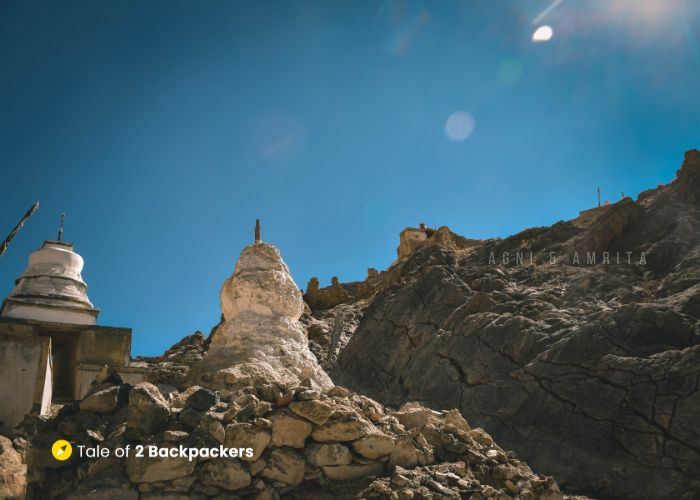
A Very Brief History of Zangla
The rule over Zangla by several vassal kings are well documented almost upto 1843 AD, just before General Zorawar Singh invaded Ladakh. Zangla always remained as a petty kingdom having allegiance to the stronger Ladakhi Kings. Renowned French ethnologist and explorer, Michel Peissel had documented that the rule of Zangla extended to about 4 villages of the Cham province of Zanskar.
The Kings of Zangla controlled such a small territory that its control was never quite challenged by the rulers of Ladakh or the Dogras, who invaded Ladakh in 1836. Thus Zangla, with its 4 small villages and the fortress remained as a separate identity ruled by the same family for a long time.
Source: Buddhist Western Himalaya: A politico-religious history By O. C. Handa
Our visit to Zangla Palace

The first glimpse of the Zangla Palace ruins had me in complete awe. The decision to visit this place seemed perfect now.
The first thing we saw as we approached the hill on which Zangla Palace is located are a number of stupas. A number of stupas were standing in complete ruins. There was no one in the near vicinity of the Zangla Palace and neither could we see anyone as far as our eyes went.
The place had a desolate look. We did not see any colourful prayer flags that are inevitably found in places like these. We felt as if we had come to a long-lost era. Time seemed to stand still there. There is a winding staircase, all broken and dilapidated, that leads to the Zangla Palace.
The Stupas

The stupas mesmerized me. As usual, ruins always seem to draw me towards them. Just like the ruins of Hampi, I invariably went towards them. I was simply marvelling at the Stupas and daydreaming about the past, when Tashi informed us that the palace was closed.
I was so disappointed. But Tashi was not deterred. We drove back to Zangla village and Tashi took us to the house of the caretaker of Zangla Palace. We requested the caretaker for keys – we in English and Tashi in the local language.
And soon, we were back again to Zangla Palace with the keys in our hand and alacrity in our hearts.
Zangla had, once upon a time, three royal palaces belonging to the Kings of Zanskar. The oldest palace was almost 2000 years old and is in complete ruins. The second one is almost 700 years old and is located on the hilltop.
Zangla Palace

We started climbing up the stone steps. There is a white stupa and a large prayer wheel almost midway to the palace. Finally, we arrived in front of the palace. Tashi opened the lock and we entered the palace. This palace or fortress is in ruins, but the architectural grandeur of the place can be clearly seen.

There is a flight of steps as you enter the palace. We climbed up to the upper level where there were a few rooms. One of the rooms was the royal kitchen as Tashi pointed out to us. The room indeed looked like one and a huge pit seemed that it could have been a place for the oven.
Another level up was a small prayer hall. There are some very old statues inside the prayer hall along with some colourful beams. The entire place looked ancient.
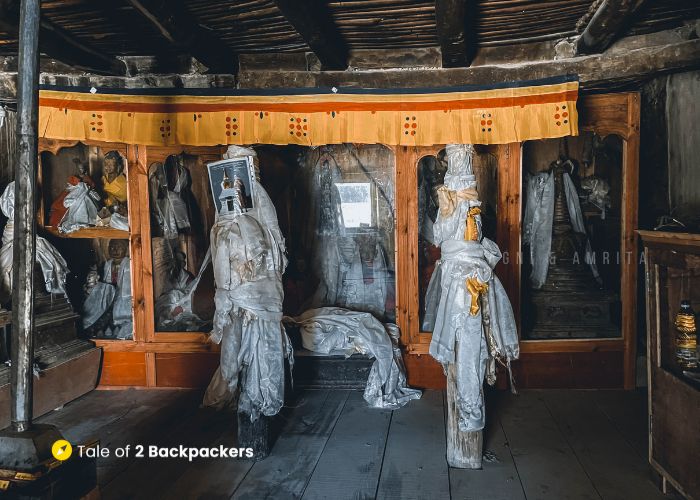
Zangla Palace and Csoma de Koros
Zangla Palace is quite intimately associated with Hungarian scholar Alexander Csoma de Koros. Csoma de Koros was the one to compile the first Tibetan to English dictionary and grammar treatise. The Hungarian scholar had studied Asian language and had a deep interest in Central Asia. In 1819, he set off on a journey from Romania to Bulgaria, Egypt, Syria, Iraq, Iran, Uzbekistan, Afghanistan and finally to India.
In India, Csoma de Koros learnt Tibetan language from a Buddhist lama in Zanskar and developed a keen interest in the religion and the religious texts. He spent a considerable amount of time in Ladakh and Spiti Valley. He spent an extended period of time at Zangla Palace in Spiti Valley. It is at Zangla Palace where Csoma de Koros compiled the Tibetan to English dictionary.

There is a room inside the monastery where Csoma de Koros is said to have worked during the period he stayed at Zangla. The room is now dedicated to this illustrious Hungarian scholar.
And oh! Did I tell you that we first heard about Csoma de Koros at our very own Darjeeling? We had seen his grave at Darjeeling old Cemetery.
Zangla Palace was totally in ruins, but several groups and NGOs are now working on restoration of the monastery, though the work is painstakingly slow. A group from Hungary had done several restorations here, especially in the places associated with Alexander Csoma de Koros.

There is a small terrace from where we got absolutely amazing views of the surroundings. At one end you can see the road from where we had come, while the other side gave a clear view of the Zangla Nunnery.
It was past noon when we finally headed back towards Zangla village. Tashi returned the keys of the palace to the caretaker.

Zangla Nunnery
Next, we headed to Zangla Nunnery. Just before reaching the Nunnery, there is the Zangla Tourist bungalow. The tourist bungalow was closed at that time and we did not see any caretaker as well.
Nevertheless, we headed towards the Nunnery. Before entering we met a few young monks who were washing clothes. They were quite jolly and were sporting huge smiles, even if they did not understand what we were saying.
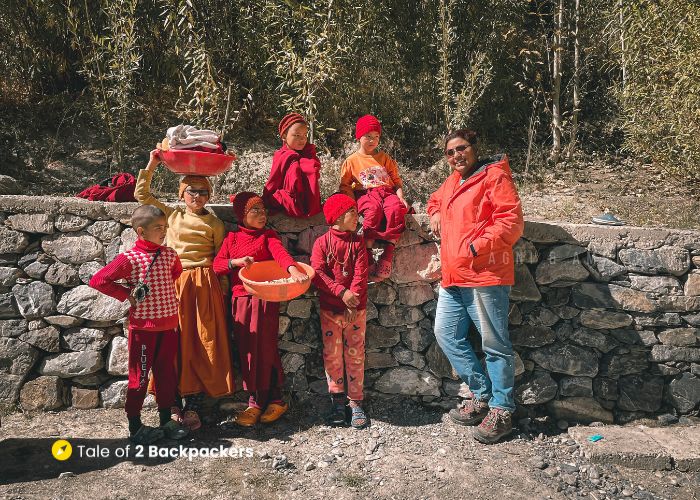
There is a prayer hall inside the nunnery and then we went on to meet the nuns. As usual, the nun welcomed us and offered us butter tea. Butter tea is one staple drink in this region. It retains heat in the body that is so much required in this cold region.

After a very enlightening and satisfying visit to Zangla, we headed towards Tsazar, our stop for the night. On the way, we visited Stongdey Monastery. But that is the story for another time, for all the places we visited in Zanskar have a story of their own.

Zangla Palace Travel Guide
How to reach Zangla Palace?
Zangla is located about 32 km from Padum town. You can hire a car from Padum and visit Zangla. Infact, you can club your Zangla day trip with Tsazar and Stongdey Monasteries.
To know how to reach Padum, read our guide on how to reach Zanskar Valley.

Where to Stay in Zangla?
Zangla has a few guest houses for tourists, that are basically the extra rooms rent by the villagers to the tourists. Staying at Zangla is a very good way to experience the local culture and life of Zanskar Valley.
There is also a Tourist Bungalow at Zangla right in front of the Nunnery.
You can also stay at Padum and visit Zangla Palace and Nunnery for a day trip. Padum has a number of hotels and guest houses.

Where to eat at Zangla?
Zangla typically does not have any eatery. The homestays provide breakfast, lunch and dinner and all the food requirements. The food served is basic.
What is the best time to visit Zangla Palace?
The best time to visit Zangla is between June to September. It is, infact, the best time to visit Zanskar Valley, as a whole. This is the time when the weather is the best and all the high-altitude mountain passes remain open.
Some Important Tips
- Remember to carry your woolen, jackets, socks and scarves with you on your visit to Zangla and Zanskar Valley. Even during the summer months temperature drops considerably in the evening and it is always better to be safe than sorry!
- The places you are visiting are quite remote. Please do not expect luxury at your stay and food. You might not even get any shops in the remote villages.
- Finally, leave the place as you found them. Do not litter and avoid using plastics as much as you can. The more you care, the safer you leave the world for your future generations.
If you are planning a trip to Zanskar Valley, please have a look at our article on How to Plan a trip to Zanskar Valley.
If you like this post, please share this with your family, friends and neighbours.
Pin it for a later read!




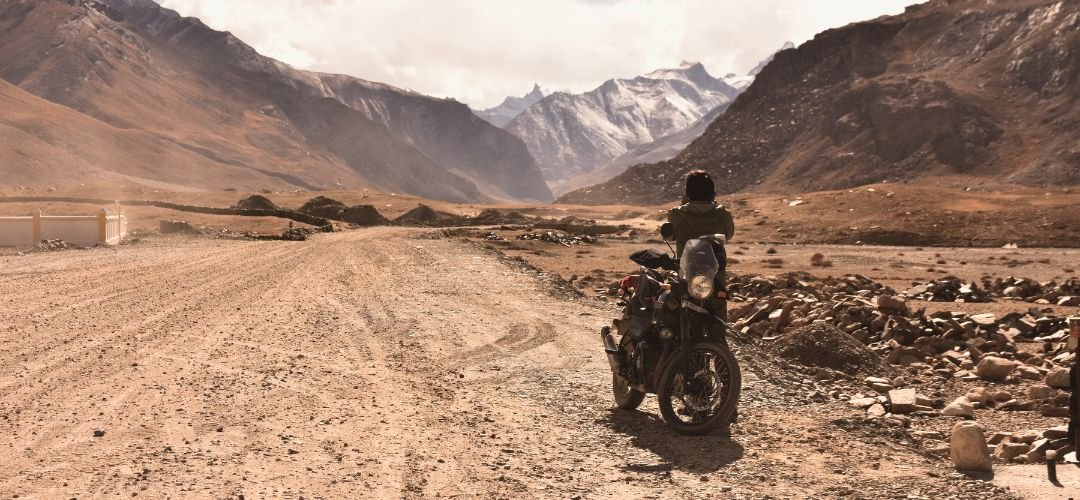
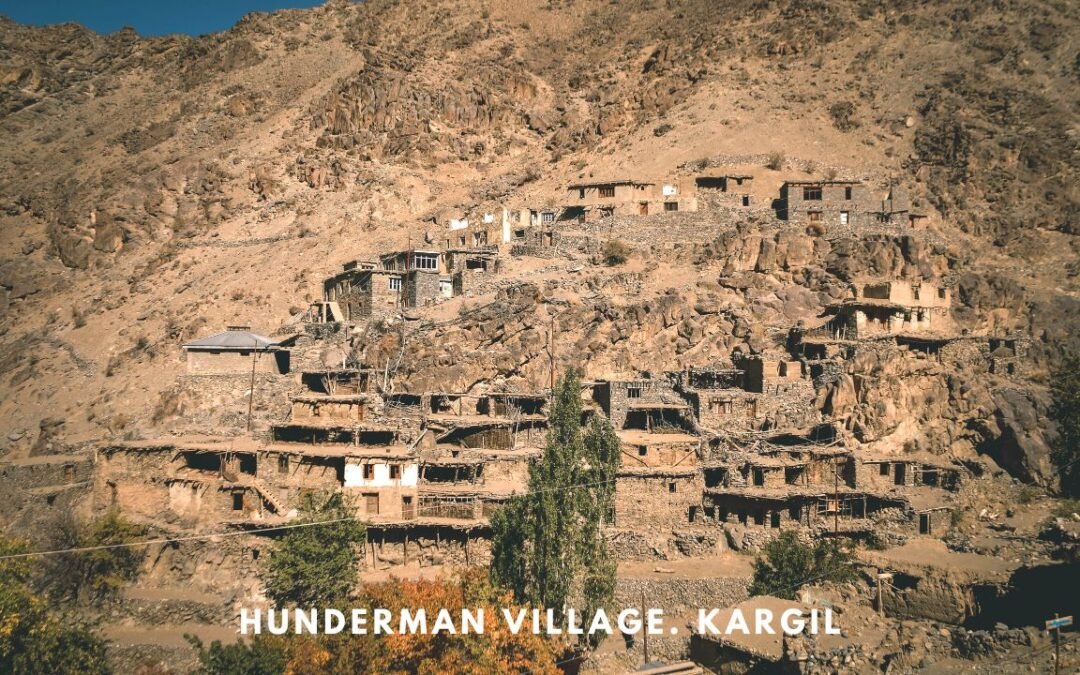
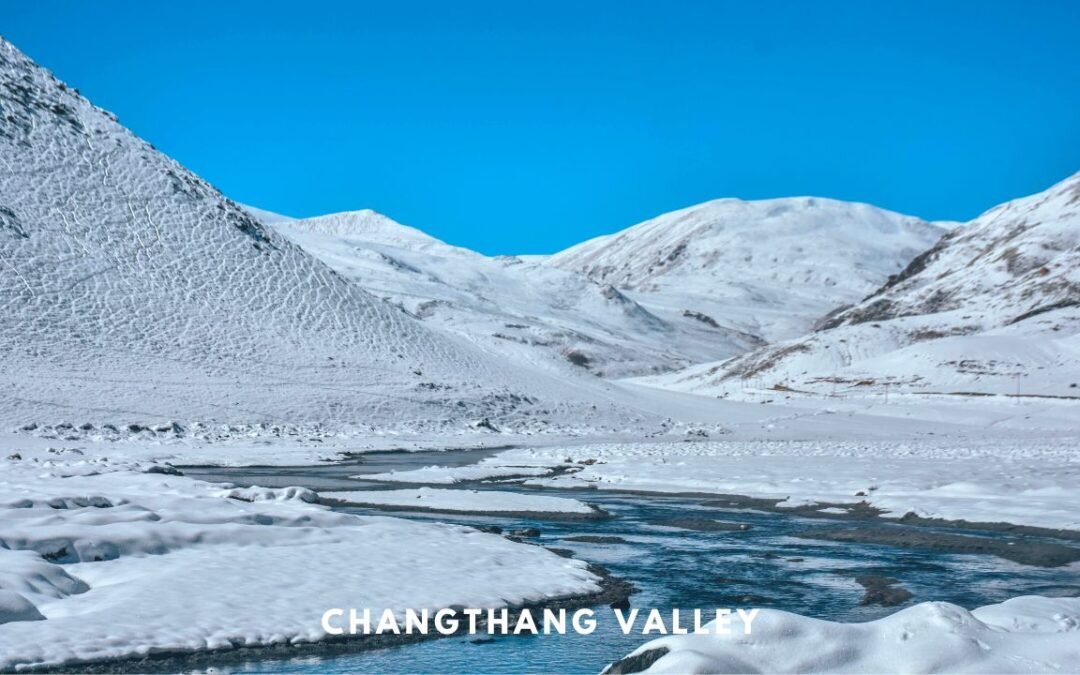
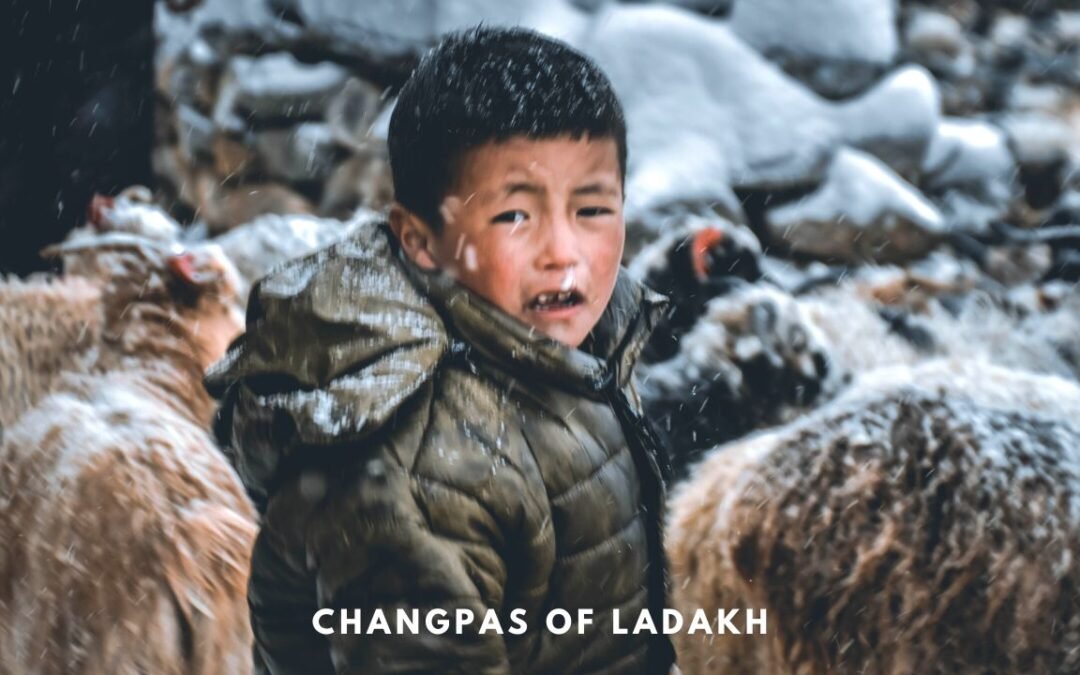


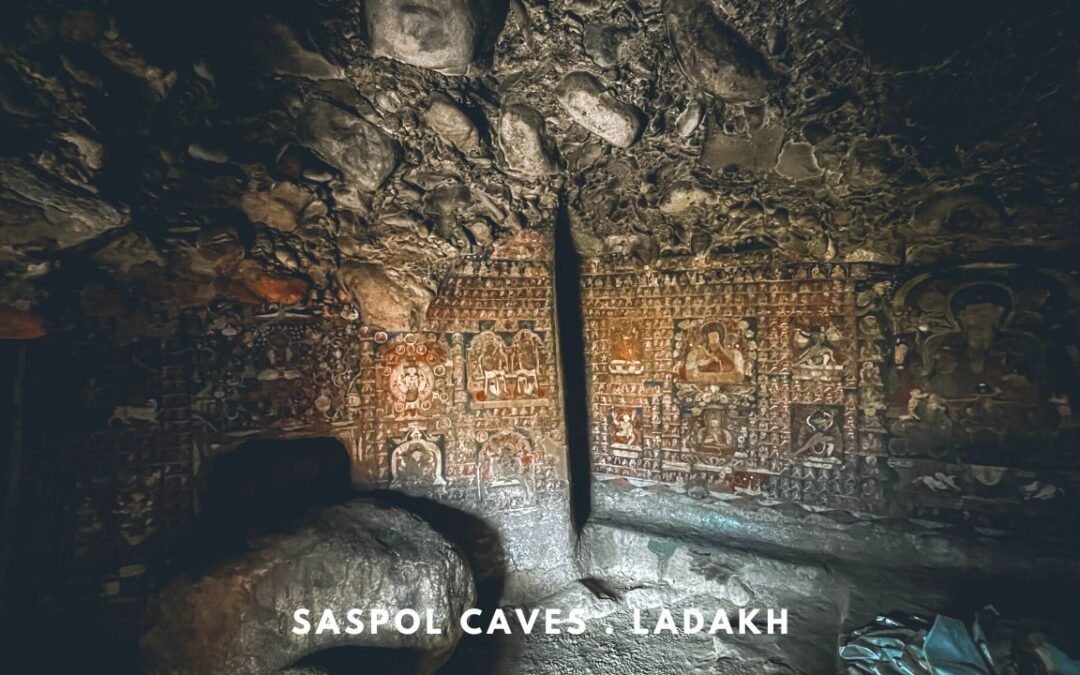

Always beautiful article.
Thank you!